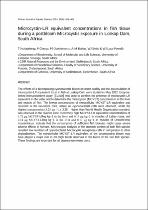 ResearchSpace
ResearchSpace
Microcystin-LR equivalent concentrations in fish tissue during a postbloom Microcystis exposure in Loskop Dam, South Africa
JavaScript is disabled for your browser. Some features of this site may not work without it.
- ResearchSpace
- →
- Research Publications/Outputs
- →
- Journal Articles
- →
- View Item
| dc.contributor.author |
Nchabeleng, T

|
|
| dc.contributor.author |
Cheng, Po-Hsun

|
|
| dc.contributor.author |
Oberholster, Paul J

|
|
| dc.contributor.author |
Botha, A-M

|
|
| dc.contributor.author |
Smit, WJ

|
|
| dc.contributor.author |
Luus-Powell, WJ

|
|
| dc.date.accessioned | 2015-03-12T09:33:27Z | |
| dc.date.available | 2015-03-12T09:33:27Z | |
| dc.date.issued | 2014-12 | |
| dc.identifier.citation | Nchabeleng, T., Cheng, P., Oberholster, P.J., Botha, A-M., Smit, W.J and Luus-Powell, W.J. 2014. Microcystin-LR equivalent concentrations in fish tissue during a postbloom Microcystis exposure in Loskop Dam, South Africa. African Journal of Aquatic Science, vol. 39(4), pp 459-466 | en_US |
| dc.identifier.issn | 1608-5914 | |
| dc.identifier.uri | http://www.tandfonline.com/doi/pdf/10.2989/16085914.2014.973830 | |
| dc.identifier.uri | http://hdl.handle.net/10204/7890 | |
| dc.description | Due to copyright restrictions, the attached PDF file only contains the abstract of the full text item. For access to the full text item, please consult the publisher's website. | en_US |
| dc.description.abstract | The effects of a decomposing cyanobacteria bloom on water quality and the accumulation of microcystin-LR equivalent toxin in fish at Loskop Dam were studied in May 2012. Enzyme-linked immunosorbent assay [ELISA] was used to confirm the presence of microcystin-LR equivalent in the water and to determine the microcystin (MCYST) concentration in the liver and muscle of fish. The lowest concentration of extracellular MCYST-LR equivalent was recorded in the lacustrine zone, where no cyanobacterial cells were observed, while the highest concentration (3.25 µg l(sup-1)), 3.25 higher than World Health Organization standard, was observed in the riverine zone. Extremely high MCYST-LR equivalent concentrations of 1.72 µg MCYST-LReq kg(sup-1) in the liver and 0.19 µg kg(sup-1) in muscles of Labeo rosae, and 2.14 µg MCYST-LReq kg(sup-1) in the liver and 0.17 µg kg(sup-1) in muscles of Oreochromis mossambicus, indicate that the consumption of sufficient fish biomass might cause severe adverse effects in humans. Microscopic analyses of the stomach content of both fish species revealed low numbers of cyanobacterial Microcystis aeruginosa cells in comparison to other phytoplankton. The extracellular MCYST-LR equivalent of the decomposing bloom may have played a major role in the high levels observed in the livers of the two fish species. These findings are important for all downstream water users. | en_US |
| dc.language.iso | en | en_US |
| dc.publisher | Taylor & Francis | en_US |
| dc.relation.ispartofseries | Workflow;14218 | |
| dc.subject | Cyanobacteria | en_US |
| dc.subject | Indigenous fish species | en_US |
| dc.subject | Labeo rosae | en_US |
| dc.subject | Liver | en_US |
| dc.subject | Muscle tissue | en_US |
| dc.subject | Eochromis mossambicus | en_US |
| dc.title | Microcystin-LR equivalent concentrations in fish tissue during a postbloom Microcystis exposure in Loskop Dam, South Africa | en_US |
| dc.type | Article | en_US |
| dc.identifier.apacitation | Nchabeleng, T., Cheng, P., Oberholster, P. J., Botha, A., Smit, W., & Luus-Powell, W. (2014). Microcystin-LR equivalent concentrations in fish tissue during a postbloom Microcystis exposure in Loskop Dam, South Africa. http://hdl.handle.net/10204/7890 | en_ZA |
| dc.identifier.chicagocitation | Nchabeleng, T, Po-Hsun Cheng, Paul J Oberholster, A-M Botha, WJ Smit, and WJ Luus-Powell "Microcystin-LR equivalent concentrations in fish tissue during a postbloom Microcystis exposure in Loskop Dam, South Africa." (2014) http://hdl.handle.net/10204/7890 | en_ZA |
| dc.identifier.vancouvercitation | Nchabeleng T, Cheng P, Oberholster PJ, Botha A, Smit W, Luus-Powell W. Microcystin-LR equivalent concentrations in fish tissue during a postbloom Microcystis exposure in Loskop Dam, South Africa. 2014; http://hdl.handle.net/10204/7890. | en_ZA |
| dc.identifier.ris | TY - Article AU - Nchabeleng, T AU - Cheng, Po-Hsun AU - Oberholster, Paul J AU - Botha, A-M AU - Smit, WJ AU - Luus-Powell, WJ AB - The effects of a decomposing cyanobacteria bloom on water quality and the accumulation of microcystin-LR equivalent toxin in fish at Loskop Dam were studied in May 2012. Enzyme-linked immunosorbent assay [ELISA] was used to confirm the presence of microcystin-LR equivalent in the water and to determine the microcystin (MCYST) concentration in the liver and muscle of fish. The lowest concentration of extracellular MCYST-LR equivalent was recorded in the lacustrine zone, where no cyanobacterial cells were observed, while the highest concentration (3.25 µg l(sup-1)), 3.25 higher than World Health Organization standard, was observed in the riverine zone. Extremely high MCYST-LR equivalent concentrations of 1.72 µg MCYST-LReq kg(sup-1) in the liver and 0.19 µg kg(sup-1) in muscles of Labeo rosae, and 2.14 µg MCYST-LReq kg(sup-1) in the liver and 0.17 µg kg(sup-1) in muscles of Oreochromis mossambicus, indicate that the consumption of sufficient fish biomass might cause severe adverse effects in humans. Microscopic analyses of the stomach content of both fish species revealed low numbers of cyanobacterial Microcystis aeruginosa cells in comparison to other phytoplankton. The extracellular MCYST-LR equivalent of the decomposing bloom may have played a major role in the high levels observed in the livers of the two fish species. These findings are important for all downstream water users. DA - 2014-12 DB - ResearchSpace DP - CSIR KW - Cyanobacteria KW - Indigenous fish species KW - Labeo rosae KW - Liver KW - Muscle tissue KW - Eochromis mossambicus LK - https://researchspace.csir.co.za PY - 2014 SM - 1608-5914 T1 - Microcystin-LR equivalent concentrations in fish tissue during a postbloom Microcystis exposure in Loskop Dam, South Africa TI - Microcystin-LR equivalent concentrations in fish tissue during a postbloom Microcystis exposure in Loskop Dam, South Africa UR - http://hdl.handle.net/10204/7890 ER - | en_ZA |





